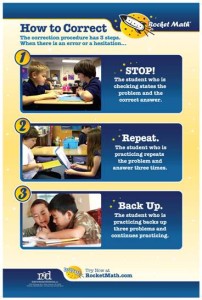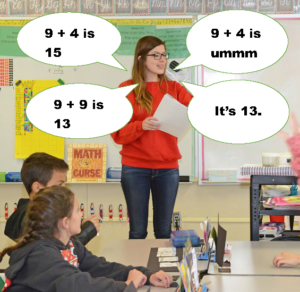 Here’s how to teach students how to do this kind of practice—and get them to comply with the procedures as well.
Here’s how to teach students how to do this kind of practice—and get them to comply with the procedures as well.
- Model how to do corrections in front of the whole class.
- —-Stop the student and say the correct problem and answer.
- —-Repeat–ask the student to repeat the problem and answer three times.
- —-Back up three problems and begin again.
- Put the correction procedures on an overhead or poster and go over them verbally.
- Explain what a “hesitation” is. (It is a second or more of nothingness before saying the answer to a fact. Students don’t have to count a second. They just need to know what it “feels” like. You will model the heck out of that later. Keep reading.)
- At first you should be the checker with a student from the class making pretend mistakes, and you tell students the three steps to the correction procedure as you model it.
Make your students model the correction procedure as you role play making errors
 Next, you take the student role and call on students to be the checker. Make both hesitations and answer errors as well as saying the wrong fact or saying just the answer.
Next, you take the student role and call on students to be the checker. Make both hesitations and answer errors as well as saying the wrong fact or saying just the answer.- Make sure the student corrects with all three steps of the correction. If they don’t do part of the procedure, prompt it until they do, then give more hesitations or mistakes for that student to get to demonstrate the correction procedure the right way.
- Once a student has demonstrated the right procedure for corrections, move on to another student.
Keep this up for the usual five to seven minutes allotted for math facts, moving from child to child having them demonstrate the correction procedure.
Script for how to prompt modeling of the correction procedure.
Here’s a link to this helpful script.
Do more practice than they need. Play “keep away” with the practice procedure.
Don’t begin the program of students working with students yet. If you do this kind of modeling for a few minutes a day for several days, students will begin to ask you if they can start doing the practice now.
OK. Here comes something really cool. Ready? Try telling them that doing practice “the right way” is really “hard” and you’re not sure they can do it “the right way” yet. Continue modeling for a few minutes a day for a few more days—not letting students actually start practicing. (Think, “Keep Away.” You know how badly kids want the ball when they play that game? Same deal here. There are actually few things as satisfying to a teacher as having students ask you to “LET” them do work. Ya gotta love that!) By the time you actually “allow” them to practice—they’ll be so anxious to prove to you that they know how to do practice “the right way” that no one will even consider doing it any other way. So around day three of practice it might look something like this:
Teacher: “Let’s do the pretend practice again.”
Student Z: “Umm, Mrs. Smith, can we please do this on our own? We know how to do it.”
Teacher: “Well, I know some college kids who can’t do this right. It’s really hard. I’m not sure that we are ready. Let’s practice a few more days.”
If you do this for two more days after the students start asking to work without your model, you will see something like you have never seen from your students before. It is a thing of beauty actually.

